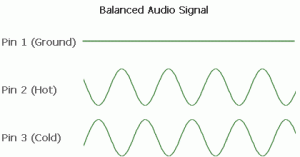 In the example note the two conductors: hot and cold (or + and -) are out of phase, moving in the opposite direction. Ground is not really needed for this to work, but typically used to provide a cleaner signal through use of a shield.
The noise on Hot and Cold is identical because it is being picked up along the length of the cable from airborne radiated sources. The preamp or source device sending the balanced signal generates the musical signal in both phases. What comes out of the transformer is a clean and perfect musical signal sans any noise or common signal.
While this is truly wonderful and something I highly recommend, is noise all that is common? No, depending on the type of circuit itself, we may be able to get even more advantages than just noise reduction.
To be continued.
In the example note the two conductors: hot and cold (or + and -) are out of phase, moving in the opposite direction. Ground is not really needed for this to work, but typically used to provide a cleaner signal through use of a shield.
The noise on Hot and Cold is identical because it is being picked up along the length of the cable from airborne radiated sources. The preamp or source device sending the balanced signal generates the musical signal in both phases. What comes out of the transformer is a clean and perfect musical signal sans any noise or common signal.
While this is truly wonderful and something I highly recommend, is noise all that is common? No, depending on the type of circuit itself, we may be able to get even more advantages than just noise reduction.
To be continued.
Inside out
by Paul McGowan
If you'll recall our discussion on balanced audio and transformers in this post, we finally got to a point of understanding how noises that are common to two conductors within a single wire are ignored. The technique is called Common Mode Rejection. Any signal of any type, common to two wires feeding the input to our transformer, is rejected. Only that that is different between the two wires is passed through the transformer. In this way, we keep what we want (the music) and we lose what we don't want (the noise). It's a wonderful process that's quite effective.
How then do we make the music different from one conductor to the next? Simple, we flip it out of phase. As the signal on one conductor is traveling in the positive direction, the signal on the other conductor is going in the opposite direction, negative. Between the two we have 180 degrees of difference.
 In the example note the two conductors: hot and cold (or + and -) are out of phase, moving in the opposite direction. Ground is not really needed for this to work, but typically used to provide a cleaner signal through use of a shield.
The noise on Hot and Cold is identical because it is being picked up along the length of the cable from airborne radiated sources. The preamp or source device sending the balanced signal generates the musical signal in both phases. What comes out of the transformer is a clean and perfect musical signal sans any noise or common signal.
While this is truly wonderful and something I highly recommend, is noise all that is common? No, depending on the type of circuit itself, we may be able to get even more advantages than just noise reduction.
To be continued.
In the example note the two conductors: hot and cold (or + and -) are out of phase, moving in the opposite direction. Ground is not really needed for this to work, but typically used to provide a cleaner signal through use of a shield.
The noise on Hot and Cold is identical because it is being picked up along the length of the cable from airborne radiated sources. The preamp or source device sending the balanced signal generates the musical signal in both phases. What comes out of the transformer is a clean and perfect musical signal sans any noise or common signal.
While this is truly wonderful and something I highly recommend, is noise all that is common? No, depending on the type of circuit itself, we may be able to get even more advantages than just noise reduction.
To be continued.
 In the example note the two conductors: hot and cold (or + and -) are out of phase, moving in the opposite direction. Ground is not really needed for this to work, but typically used to provide a cleaner signal through use of a shield.
The noise on Hot and Cold is identical because it is being picked up along the length of the cable from airborne radiated sources. The preamp or source device sending the balanced signal generates the musical signal in both phases. What comes out of the transformer is a clean and perfect musical signal sans any noise or common signal.
While this is truly wonderful and something I highly recommend, is noise all that is common? No, depending on the type of circuit itself, we may be able to get even more advantages than just noise reduction.
To be continued.
In the example note the two conductors: hot and cold (or + and -) are out of phase, moving in the opposite direction. Ground is not really needed for this to work, but typically used to provide a cleaner signal through use of a shield.
The noise on Hot and Cold is identical because it is being picked up along the length of the cable from airborne radiated sources. The preamp or source device sending the balanced signal generates the musical signal in both phases. What comes out of the transformer is a clean and perfect musical signal sans any noise or common signal.
While this is truly wonderful and something I highly recommend, is noise all that is common? No, depending on the type of circuit itself, we may be able to get even more advantages than just noise reduction.
To be continued.
- Choosing a selection results in a full page refresh.
- Opens in a new window.








